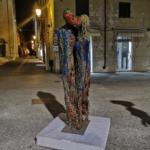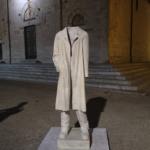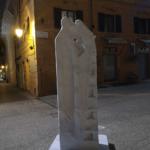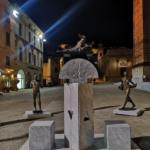 Art challenges Covid19 and relaunches the theme of hope and beauty but also of distance and reconciliation with THE PIAZZA IN ATTESA exhibition promoted by the Municipality of Pietrasanta and Nag Art Gallery has opened in Piazza del Duomo in Pietrasanta until June 2021.
Art challenges Covid19 and relaunches the theme of hope and beauty but also of distance and reconciliation with THE PIAZZA IN ATTESA exhibition promoted by the Municipality of Pietrasanta and Nag Art Gallery has opened in Piazza del Duomo in Pietrasanta until June 2021.
The touring exhibition was born in these months of the fight against the pandemic between restrictions, deprivation and pain and was the brainchild of the gallery owner and curator Vincenzo Nobile. It brings art with its powerful messages into the belly of the international capital of sculpture through eleven “sculptural figurations” in marble, bronze and other mixed techniques by eleven artists who have gravitated around the artistic and productive reality of Pietrasanta for many years such as: Tony Nicotra, Daphnè Du Barry, Enrico Savelli, R. Bonetti, Boutros Romhein, Katarina Victor-Thomas, Misja K. Rasmussen, Alba Gonzales, Algarco, Alessandra Politi Pagnoni, Tano Pisano, Lorenzo D’Andrea.  The works are positioned in a circle, in a sort of Stonehenge of art. They become strictly symbolic: finely polished and compact, endowed with an internal plastic motion that opens up radiating outwards, twisted knots, intertwining and biomorphic shapes, together with upward strokes and sinusoidal elements, constitute the artistic lexicon. Everything is born and transformed into an idea by chance, without spasmodic and deliberate research. Nature is the main source of inspiration, everything that surrounds us can be a source of inspiration for new ideas, the sensitivity of an artist is that which, at the right moment, picks up the formal cue…
The works are positioned in a circle, in a sort of Stonehenge of art. They become strictly symbolic: finely polished and compact, endowed with an internal plastic motion that opens up radiating outwards, twisted knots, intertwining and biomorphic shapes, together with upward strokes and sinusoidal elements, constitute the artistic lexicon. Everything is born and transformed into an idea by chance, without spasmodic and deliberate research. Nature is the main source of inspiration, everything that surrounds us can be a source of inspiration for new ideas, the sensitivity of an artist is that which, at the right moment, picks up the formal cue…
Interview with gallery owner and exhibition curator Vincenzo Nobile:
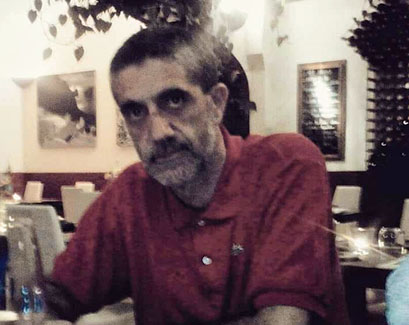
1)Let’s talk about your personal history first, how did this love of art come about?
My love for art was born in Ragusa, a Sicilian town, rebuilt after the earthquake of 1693. The Baroque architecture and aesthetics of those years dominated and prevailed over the stylistic fashions of the following years and centuries. I was born and lived until the age of 19 in this city made of limestone, visible in the surrounding landscape in its natural state and masterfully carved and sculpted in the streets and fine buildings, but also visible in the tiny houses. Afterwards, I moved to Florence to study architecture and in the city of the Renaissance I worked on urban planning, building restoration, interiors, design… and I lived there for 30 years. In 2010, at the Pontile in Pietrasanta, I attended the presentation of some sculptures by the artist Alba Gonzales, and I was struck by one in particular, “Justice”, a 220 cm tall bronze sculpture depicting a woman’s body caged in the earth, her face turned to the four sides and her gaze turned to the sky. I reflected on the work and asked about the artist, finding a review by Antonio del Guercio, a professor at the University of Florence, with whom I had brilliantly discussed the exam on the history of contemporary art. I opened an art gallery in Florence, dealing with emerging contemporary artists, but after two years I decided to close it. Then I had a couple of exhibitions in a hotel in Capri, where I put the bronzes of Alba Gonzales in relation first with a Capri painter and then with a Sicilian one.The summer experience lasted 100 days. In 2015 I returned to Pietrasanta and in a small space in the historic centre, I began to exhibit local or foreign artists who had chosen to live and work in this town in Versilia.
This town in Versilia, a hub of artistic tradition and naturally nestled between the Apuan Alps and the sea.
Enthused by the ease with which artists and contemporary art enthusiasts met, I set up the NAG artgallery in 2016.
A street in the centre of Pietrasanta has always been trodden by great artists, starting with Michelangelo, and by marble and bronze workers who, with their professionalism, have made this small reality known as ‘little Athens’.
 2) How can you keep a gallery open at the time of Covid19?
2) How can you keep a gallery open at the time of Covid19?
The NAG art gallery is one of the 30/40 galleries in the historic centre of Pietrasanta, the number is very important but varies according to the season. We have decided to be open all the time, in summer and winter, and we are open 360 days out of 365.
Even during 2020, we remained open all the time, except for the period imposed by the regulations in force, but to keep us active during the lockdown we collected 61 works produced by 61 contemporary artists during the dramatic period and posted them on social media commenting on them vocally for 60 seconds each.
In 2021, foreseeing a situation of closure of the gallery in the spring, imposed by anti-violence regulations, as in the previous year, we decided to project the exhibition activity outside, in Piazza Duomo in Pietrasanta. The theme underlying the choice of works and the language used is intended to underline the times and conditions in which we are living.
3) How is contemporary art represented today in relation to the past?
For us, contemporary art can only relate to the works of the past if it reaches levels of professional technique, of knowledge of the material used, so as to be able to draw all the best expressive capacities from it; art is know-how. Contemporary art can only remain part of the past if it succeeds in recounting to posterity something that no longer exists, but which remains for the beauty with which it was created, which is preserved with admiration for the passion it conveys, which is preserved with devotion for the effort with which it was produced. Contemporary art reaches levels of universal appreciation only if it succeeds in foreseeing and expressing future behaviour, situations that the sensitivity of a few men expresses to the advantage of the multitudes, new languages to express imminent anxieties that would otherwise leave us insensitive. Art in general is knowing how to do anything well; painters, sculptors, architects and contemporary artists must know how to do it in order to be remembered.
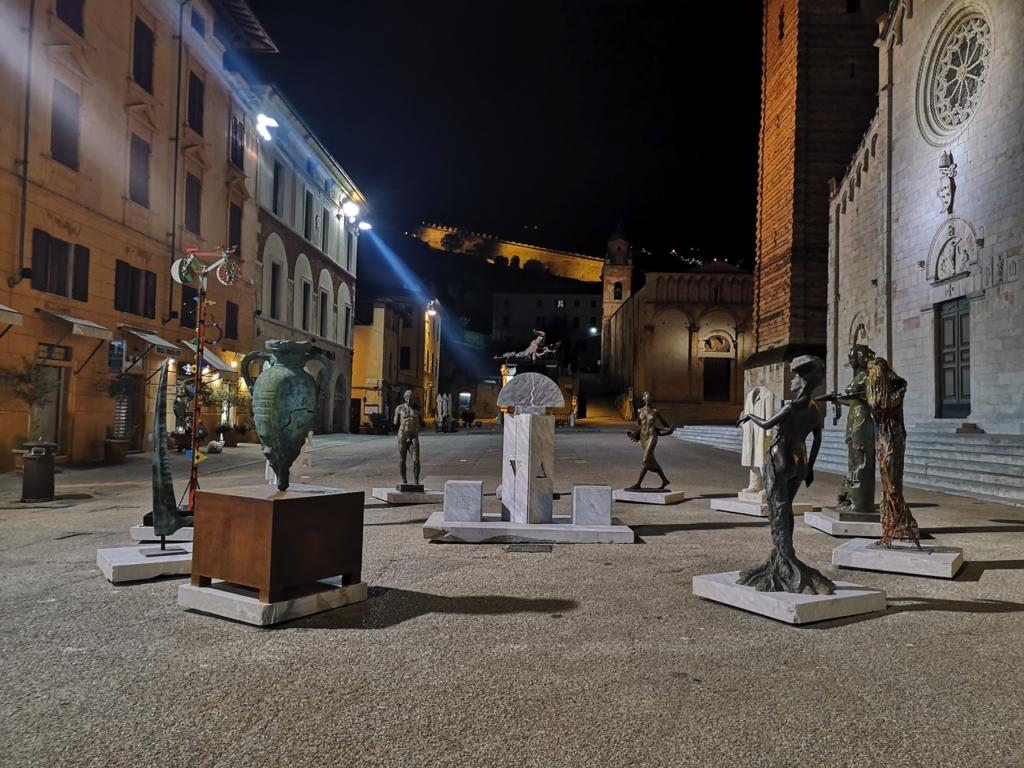 4) how did this latest exhibition project come about?
4) how did this latest exhibition project come about?
The desire to bring the square to life, the reconciliation between people and the ability of sculpture to arouse emotions, in the expectation of a rediscovered way of existing, are the premises of the exhibition in Piazza Duomo in Pietrasanta. The square is waiting to rediscover that complexity of situations that brought together multitudes of people and things. In urban aggregations, from the Greek polis to contemporary cities, the square has for centuries contained people, animals, goods, orators, theatrical performers, those condemned to public ridicule, etc. This is why the street, an element linking distant polarities, widens and expands to accommodate the complexity of being together. Today, the squares of our cities have been emptied by the anti-covid regulations, and while waiting for them to come to life as soon as possible, we have selected sculptural figures, divinities, symbols of good fortune, justice, life, love, fragments of animals, playful elements, to recreate in a metaphysical way the vitality, alas inanimate, of the square we have always been used to.
5) Do the works in marble, bronze and mixed materials and techniques, works chosen in dialogue with the environment, very much reflect society today? How do they influence it?
The works, made by artists who have chosen Pietrasanta, sculpted in Apuan marble, moulded in bronze in the artistic foundries of Pietrasanta or even those made in mixed materials and techniques, are linked to the surrounding environment, as they are the result of it. The sculptures proposed are in fact the product of this site, the upper Versilia. Professionals that have been handed down for centuries create artefacts that are unique in the world, and those that are derived from methods other than traditional production are the result of technological innovation that is continually adapting to our times in this place.
 6)Let’s talk about how “LA PIAZZA IN ATTESA” was born, which path will then continue abroad…
6)Let’s talk about how “LA PIAZZA IN ATTESA” was born, which path will then continue abroad…
The desire to bring the square to life, the reconciliation between people, the ability of sculpture to arouse emotions, in the expectation of a newfound way of existing, is the objective of the exhibition in Piazza Duomo in Pietrasanta. We have imagined a parterre, made up of eleven sculptural figures and a preferential point of view in the centre, a resting place. A traditional bench with an element in the middle that dissuades people from sitting together, as regulated by current regulations. The authors of these twelve works of art, made of marble, bronze and mixed materials and techniques, are artists who have gravitated around the artistic and productive reality of Pietrasanta for many years. The ideal parterre on which the sculptures stand is circular in shape. Visitors to the square will be able to move among the works, exchange and mingle with the sculptures, touch them and grasp the emotions that the artists wanted to arouse with their works. THE SQUARE, a place that has always been at the service of the exchange of goods, of relations, of productive and creative activities, now appears to be WAITING for an event that can reassure people and give hope for a new social balance.
THE PIAZZA IN WAIT in Piazza del Duomo, Pietrasanta, until June 2021.
Place: PIAZZETTA SAN MARTINO
Address: Piazzetta San Martino – Pietrasanta – Tuscany
When: from 19/03/2021 – to 23/05/2021
Vernissage: 19/03/2021 at 4 p.m.
Genres: contemporary art
Info : NAG Art Gallery, via Stagio Stagi, 86 – Pietrasanta – info: www.nagartgallery.com
She is an independent curator, art advisor and international marketing management consultant. For more than 20 years, he has been a cultural designer of events related to contemporary art with particular attention to unusual spaces and interactions with other arts.



